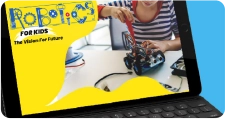
Moonpreneur
Sensor-based appliances are slowly permeating our everyday life. The home appliance market is replete with sensor-operated devices. The smart lighting market, backed by sensor technology, is expected to hit the target of a whopping USD 44 billion by 2030.
Sensor technology makes modern life relatively easier and hassle-free. So, if your child is learning robotics or planning to enroll in it, they should know the basic types of sensors to get started.
As parents, you must feed your child’s inquisitive minds with apt answers so that they understand the sensor technology. With every second gadget at home that relies on sensor technology, it is important to inform them about this modern technology.
If you are not sure where to start, this blog will help you to initiate a techy conversation with your children.
The blog enlists the top 4 types of sensors used in our daily lives.
But first, let’s understand the basic definition of a sensor!
What is a Sensor?
A sensor is a device capable of detecting or capturing data from the surrounding environment and then converting the data into electric signals. The data can be in the form of light, heat, motion, moisture, pressure, and so on. Next, a microprocessor further processes the electronic signals into actionable outputs.
The system aims to communicate the final output with the users through readable displays, notifications, etc. Depending on the purpose of any gadget, it may consist of multiple sensors. For instance, your refrigerator has a couple of sensors (door sensor, lid sensor, level sensor, temperature dial sensor, etc.) that serve different functionalities.
Types of Sensors Your Children Should be Aware of:
1. Motion Sensors
Does your child get startled by the glass doors which open automatically in different malls? Do the self-moving elevators at metro stations keep them puzzled? Tell them that this is no magic. Rather it is pure science.
All these devices leverage top-notch motion sensors, which can detect people’s presence flawlessly.
The sensors detect motion and send signals to trigger processes like the movement of elevators or the opening of gates.
2. Smoke Sensors
Have your children ever run into a problem at school after creating smoke in a science lab and setting off the fire alarm?
Smoke sensors are fitted in residential as well as commercial buildings. Schools and hospitals, too, rely on smoke sensors to avoid any mishap related to fire breakouts.
Basically, smoke sensors can detect smoke instantly and trigger emergency alarms to alert people around. The idea is to minimize the extent of the damage and save precious lives and properties.
3. Thermal Sensors
Enjoying a comfortable temperature inside the room is possible because of thermal sensors. The air conditioner in your house that says “Weather control” leverages a thermal sensor to ensure that the internal temperature stays comfortable and constant, despite external temperature fluctuations.
Also, the geyser or water heater that cuts off electricity once the water gets heated up as per your requirement also works on the same principle.
4. Light Sensors
Children generally feel surprised to see a room automatically lit up as they step in. Do not feed their inquisitive mind with made-up magical stories. Rather, introduce them to light sensor technology.
Light sensors are commonly used in smart homes, office complexes, and several other places with the aim of cutting down on unnecessary energy bills. Also, light-sensor-backed devices make it easy for elderly people, toddlers, and specially-abled people.
Wrapping Up!
Walking your child through the concept of sensors can be an interesting activity. Once you help them understand the purpose of sensors, your children may show an enhanced interest in the world of technology and automation.
Enroll in Moonpreneur’s value-packed online robotics classes for children and introduce your child to the world of sensors. You can also try our 60-min free robotics workshop or talk to our program consultant at +1 (855) 550-0571.











